You need a new liner for your swimming pool but are told you'll have to "AB measure" your pool and now you're wondering how in the world you even do AB Measuring. Getting accurate measurements for a new liner is critical for the liner being made to correctly fit your pool so while this may not seem like a good time to learn a new skill, with our help and a little patience, you'll be AB Measuring like a pro (the first time around)!
Below are the important steps needed to AB measure your swimming pool for a new liner. The good news is that none of it is difficult, but it will take some time. Know that going in so you stay patient. Slow and steady wins this race, my friends.
Tips for Accurate AB Measurements
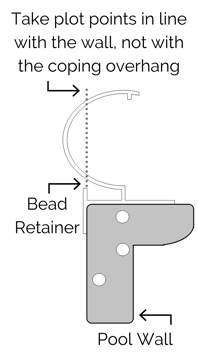
- Chalk is an mess free, easy way to mark your plot points
- Use consistent units of measure (Imperial feet and inches, NOT just inches)
- When plotting points, mark where the actual pool wall would come to (see image), NOT to the edge of the coping or deck
- Likewise, measure the perimeter along the actual pool wall, NOT the coping
- When measuring the distance between A& B and the plot point, be careful not to fix up A & B
- Do not round measurement; measure to the nearest 1/4 inch for accuracy
- When measuring depth and wall height measure from the bead retainer to the floor, NOT from the top of the deck.*
- Indicate any changes in the pools shape and provide necessary measurements for:
- Safety ledges, the width of ledge at the back slope and side slopes
- Break-off measurements and locations
- The Coves slopes and depth
- Convex slopes measurements and location(s)
- Changes in wall height
- Provide photos of the entire pool in one image, if there are areas of concern show them from different angles and distances.
When measuring a pool it is helpful to "square" radius (rounded) or grecian (diagonal) corners. This is especially important when measuring L shaped pools (Lazy or True style), as well as when taking diagonal measurements.
By squaring the corners:
- You have a common point of reference for length, width, and diagonal measurements.
- You can quickly determine if the pool is actually square by examining the pool's completed measurements
- If the pool is square you can determine the accurate corner size.
- It is much easier for manufacturer's to reconstruct the measurements into your pool's precise shape
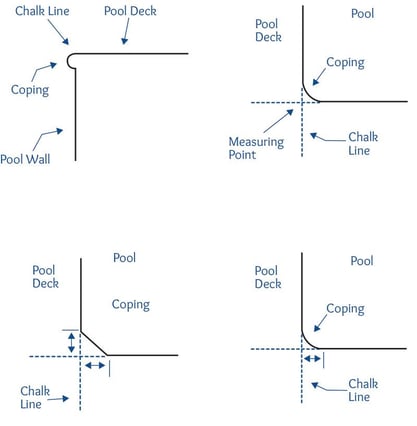
To square a corner you need to extend the straight wall past the corner. This is very easy to do, most recommend simply snapping a chalk line. Do the same thing with the other straight wall that makes up the corner. See the above examples. IMPORTANT: Make sure to line up the string for the chalk line with the bead track, not with the edge of the coping.
Use where your two chalk lines intersect as your point of reference for measuring.
1) Draw the AB Line
To get scale and measurements correct, you need to establish two points for your AB line. An AB line is a straight line you mark on your deck about 4-5 feet out from the edge of your pool.
When facing your pool, point A must always be on the left of point B.
Point A and point B should be on a flat surface and the line, if it were to extend out, should not cross the pool at any point. See the example below.

Point A should be a minimum of 10 feet apart form point B however, a good rule to follow is the AB line should be about two-thirds the length of the pool. So for example, if your pool is 40 feet long, the distance between point A and point B should be roughly 26 feet.
Once you have the ideal AB line location, mark the line on your deck. We recommend a chalk line as this is more accurate than a hand-drawn line.
A chalk line is a tool that spools out chalk-covered string. The string is used to draw a straight line from point to point by using the tight line of string. Snap the string against your deck to create the line.
Measure the distance between point A and point B, as well as each point's distance to the pool. Notate these measurements in the proper fields on your measurement form.
2) Mark AB Points
Halfway between the A and B points, walk to the edge of your pool. This will be point location 1. Mark it as "1" with chalk on the inside edge of the pool. While you can either measure the distances from A & B to the this point now, we find that folks have an easier time with this process when they plot the entire pool first and then do your measurements.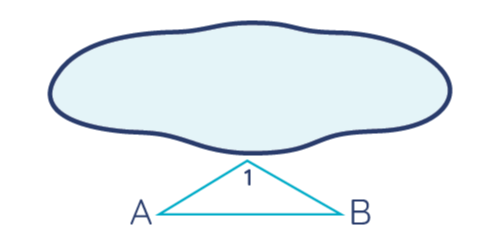
From there, move clockwise, and mark a "2" approximately 2-3 feet away from point "1". The distance between points can vary and do not have to be exact. If you are marking points within a sharp curve or corner, your points will want to be closer to 1-2 feet. If you are marking points along a straight section you can make them further apart. Always make any corners or obvious bends a point.
Continue clockwise, marking the next number every 3 feet out. You want to use numbers instead of tick marks. You will need to reference numbers later down the line and will not want to have to count 70+ something tick marks to know which point you're referencing. Trust us, use numbers.
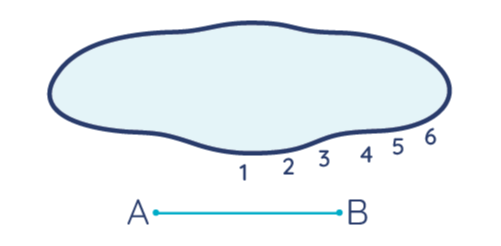
3) Measuring the Distance from A, and the Distance from B
You can measure from A & B two different ways. Either use two different color tape measures (one fixed to each A & B stake) and measure from both A & B at the same time (just make sure you have an easy way to remember which color goes with each stake). If you go this route you'll want to pull both tape measures to point one on your pool's perimeter at the same time. You'll record the measurement you find from tape measure A (attached to the A Stake) in the A column on your measuring form and repeat for B.
If you only have one tap measure, you can measure from Stake A first and then go back to do B, as shown below. Secure the end to point A on your AB line and measure the distance to point #1. Note the distance in the "A" column on the chart provided within the form. Continue around the pool until you have recorded all your points with an "A" measurement.
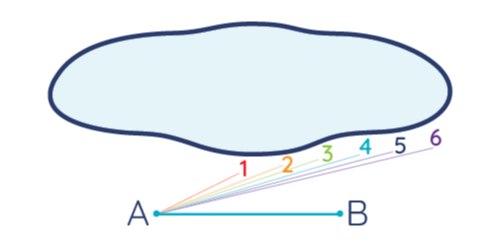
Then secure your measuring tape to point B and repeat the process.
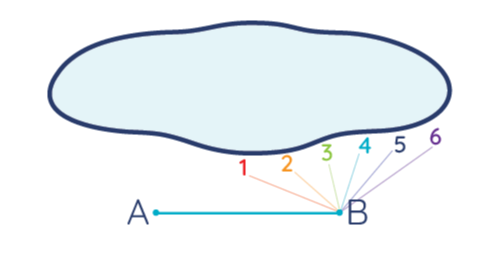
PRO TIP: Go back and spot check a couple of measurements again to make sure they are as accurate as possible.
4) Reference Distances
Finally, take 3-4 diagonal measurements randomly from numbered points across the pool. This allows the cover manufacturer to have cross dimensions to reference. Note the numbers used and the distance between in the spaces provided on the form.
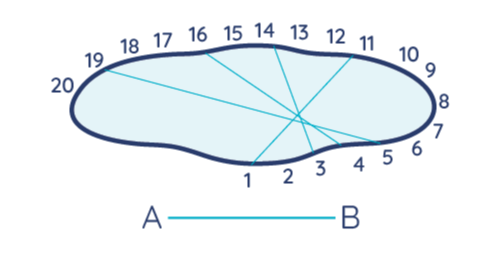
Measuring bottom dimensions
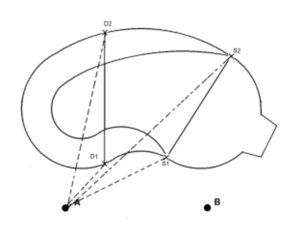 Make sure to mark the points where the break begins and ends to help establish bottom dimensions. The break is the point where the shallow end starts to transition into the deeper section of your pool and then meets your hopper (the deepest part o the pool floor).
Make sure to mark the points where the break begins and ends to help establish bottom dimensions. The break is the point where the shallow end starts to transition into the deeper section of your pool and then meets your hopper (the deepest part o the pool floor).
When measuring the back and side slopes of the deep end, use one of the points you've established around the pool to measure from. Then note which point was used and measure straight out from that point.
Take the depth measurements at the back of the hopper where the back wall starts as well as the sides of the hopper where the side walls start.
These slopes are measured horizontally from the pool wall to the edge of the slope around the hopper. For the the required pool depth, use your telescopic pole and a plumb bob to measure the vertical depth at the edge of the slopes along the hopper. It's recommended that you measure from several slope bottom points around the hopper. When recording your measurements, remember to subtract the distance from the top of the deck to the bead retainer to provide the accurate depth of the pool and have a properly fitted liner.
Measure the depth of the shallow end and make a note if the shallow end isn't flat or if there's a cove.
Measuring Vinyl-Over Steps
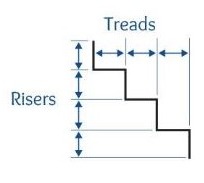
Finally, it may seem obvious, but don't forget to include the location of the step in your drawing.
Measuring Bolt-On Fiberglass Steps
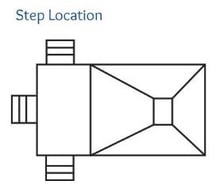
If you do not have vinyl over steps, you're not completely off the hook. There are some measurements you'll need to take as well.
If your step location comes out from the perimeter of the pool as shown here, pay special attention to the two sides of the step that connect o the pool walls.
Does the opening of the step (where you would exit the step and enter the pool) follow the curve of your pool's shape; or does your step cut a straight line into your pool's shape?
 In the freeform pool here, the step juts out form the pool's perimeter and the step mouth or opening does not follow the pool's natural perimeter. You'll want to make this note on your measurement form and show this in your drawing.
In the freeform pool here, the step juts out form the pool's perimeter and the step mouth or opening does not follow the pool's natural perimeter. You'll want to make this note on your measurement form and show this in your drawing. Draw Your Pool with AB Scale Notation
Once you have all your measurements, make your art teacher proud by creating a sketch of the pool, as close to scale as you can. A scale drawing means that the dimensions are the same but the size is smaller. For example, one-centimeter on your drawing might equal one-foot for the pool. Use graph paper for the best results. There's space provided on the liner replacement measurement form form for this.
You'll want to clearly show the locations of the hopper (Deepest part of your pool) and the break points for your slopes.
The AB line has to be in the same location on your drawing as it is physically with respect to your pool. Make your drawing match as much as you can.
Draw your pool's shape, the numbered marks, and the special features/obstructions into a scale-image drawing of your pool. DO NOT FORGET TO INCLUDE WHERE YOUR AB LINE IS AND IT'S DISTANCE FROM THE POOL. This will give us enough reference measurements to create the correct cutout for your pool cover.
Take Photos of the Pool and Features
It is very helpful to also have corresponding photos of your pool. This will help us how to translate your drawings into a real-world cover. Snap multiple photos of your pool from various angles with the AB stakes and chalk plot points still in place. If you have a balcony, second story, or even a drone (finally an excuse to use it), an overhead photo of the pool is also very useful.
Fill Out the Form and We'll Do the Rest
Finally, collect all your measurements, notes, and drawings and fill out the custom pool cover measurement form entirely. Then send the form to support@royalswimmingpools.com along with your attached photos letting us know that you'd like a new liner. We'll take it from there! (if you have a preferred liner type, brand, style, pattern, etc. let us know in your email).
We hope that you've found this article helpful. If you have suggestions for how it can be improved or if you have a question, feel free to leave us a comment below.

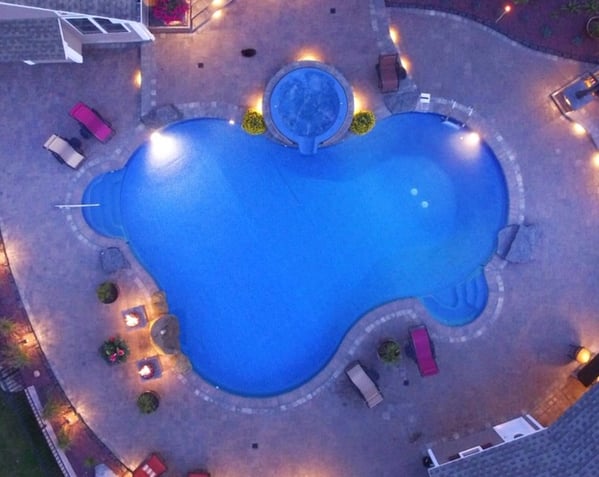

.jpg?width=700&name=pool%20essentials%20POOL%20LINERS%20(option%202).jpg)


